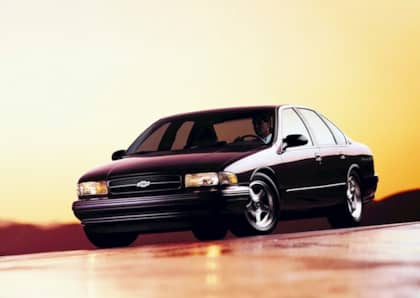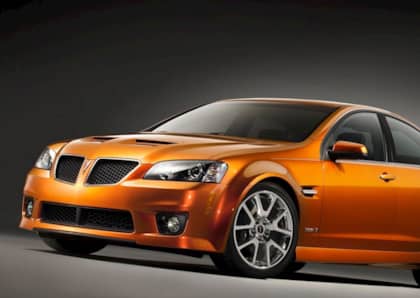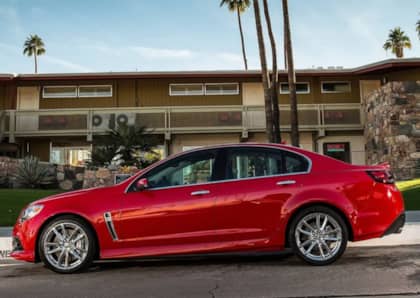Head To Head: Comparing The Chevrolet Impala SS and the Mercury Marauder, The Last Gasp Of Big American Body-On-Frame Muscle
It might seem difficult to imagine now that sport-utility vehicles dominate nearly every sales category, but there was a time when big four-door sedans where seen as the apex of American motoring, with Ford, GM, and Chrysler all building variants of this popular template. By the time the 1990s rolled around it was clear in Detroit that traditional full-frame, rear-wheel drive designs were on their way out, but two automakers would ride the tail end of the enthusiasm for these designs as a way to squeeze just a little extra profit out of ancient platforms about to roll into the scrap yard of history.

Along the way, each managed to whip up an unlikely legend. It's rare that a high performance model of an aging family car becomes firmly lodged in the enthusiast zeitgeist, but that's exactly what happened with the final generation versions of the Chevrolet Impala SS and the Mercury Marauder. Each of these models revived not just long-abandoned name plates, but also evoked muscle car memories as they enjoyed a last few years in the sun prior to retirement.
Keeping It In The Family
Built between 1994 and 1996, the Chevrolet Impala SS borrowed its bones from a familiar face: the Caprice, which had served as the Bowtie's largest family car in the showroom for decades. Although it received a redesign for 1992, going from box to bubble in terms of its body work, slow sales, mediocre fuel economy, and limited investment from the mothership made it clear that the Caprice was playing out the string.

Still, in terms of being an unexpected performance platform the Caprice had all of the elements in place Chevrolet needed to make a splash. A popular choice with law enforcement across the country, the 9C1 edition of the sedan delivered Chevy's 5.7L LT1 V8 engine along with upgraded suspension and cooling, features that could easily be ported over into a civilian factory hot rod. Reviving the Impala SS name for use on a Caprice-derived vehicle was also an easy choice, given that these two models had often shared body work in the past.

The Mercury Marauder followed nearly a decade later, running from 2003 to 2004, and it borrowed nearly the exact same playbook as its Chevrolet predecessor. The vehicle was based on the pedestrian Mercury Grand Marquis, itself a badge-job of the Ford Crown Victoria, only this time the heart transplant came not from the Blue Oval's police package catalogue but rather the Mustang. Under the Marauder's hood sat a 32-valve, all-aluminum 4.6L V8 borrowed from the Mustang Mach 1, versions of which having previously pulled duty in the Mustang Cobra and the Lincoln Mark VIII coupe. The name evoked the go-fast full-size Marauders of the '60s and '70s, while adding monochromatic flourishes to the Grand Marquis' familiar shape to help distinguish from the rental fleet and retiree chariot its donor platform had become.
Borrowed Rockets
Power-wise, the 94-96 Chevrolet Impala SS was a virtual match for the 9C1 Caprice. Although this motor was also found in two-door muscle machines from Chevrolet in the same era, the tune for the Impala SS was a little more modest, checking in at 260 hp and 330 lb-ft of torque. Matched with a 4-speed automatic transmission, that was good enough for a 6.5-second run to 60-mph, and a quarter mile clock of 15.4 seconds.

Those numbers aren't all that flashy today, but in the mid-'90s they carved out a balanced niche between fun and fast for a family car that weighed in at over 4,000 pounds. A slightly lowered suspension system and the extra beef from the cop shop package (including thicker sway bars) helped corral some of the tipsy character of the Impala SS when pushed through a corner, but this was still much more of a cruiser than anything else, which again reflected the badge's history at Chevrolet.

The Mercury Marauder offered bit more technology for fans of big-boned performance, replacing the Impala SS pushrods for the dual-overhead cam design of its modular V8. Delivering nearly 80 ponies more than the standard Grand Marquis (which made do with an iron-block, 2-valve version of the 4.6), the Marauder's 302 hp and 318 lb-ft of torque split the difference with the Chevrolet on the spec sheet. With its higher-revving character and lack of low-end grunt, the Marauder was actually a tad slower in a straight line, requiring 7.5 seconds to hit 60-mph and 15.5 seconds to complete the quarter mile.

A 4-speed automatic was also along for the ride in the Mercury, and its chassis was a mix of one-off shocks and springs lifted directly from the P71 police edition of its Crown Victoria sibling. Handling was a touch above that of the Chevrolet but still informed by its bulk and size, and top speed was limited to a mere 117 mph due to concerns over driveshaft vibration.
Distinct Personalities
Visually both the Impala SS and the Marauder did an excellent job of standing out from their less extroverted starting points.

Chevrolet took the Caprice and added a unique grille, smoothed-out and chrome-free body work, 17-inch rims, a center console shifter, and an embossed IMPALA SS on the rear flank, topped off with a limited color palette (black, deep red, or green).

Mercury pulled a similar black-out on the Grand Marquis, stripping shiny trim and going body-color wherever possible (in black, silver, blue, and red), while installing a unique gauge cluster and seating setup of its own.
Last Of Their Breed
GM canceled the B-body platform across the board for 1996, and that was the end of the last rear-wheel drive Impala SS. Although Cadillac and (briefly) Pontiac would return to rear-wheel drive with sedans in the following decade, it would be more than 20 years before Chevrolet once again tested those same waters by way of the Caprice PPV and then the four-door SS (minus its Impala designation).

The actual Impala moved to a front-wheel drive platform and bounced around between V8 and V6 power plants, never again achieving the kind of lasting cultural cachet garnered by the 94-96 model.

The Marauder's equally short run was done in by bean counters at Ford more concerned with the bottom line than with establishing Mercury's bonafides with performance fans. This was in full display when the middle of the initial 2003 model year saw the car stripped of numerous features in a bid to reduce production costs. By the end of 2004, the Grand Marquis remained but the Marauder was history, and seven years later (its line-up having been stripped of anything other than lightly disguised Ford clones), so was Mercury.











